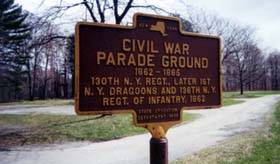 |
|
Photo by Tom Breslin |
This was the first unit to train at Camp Williams. Their history is dramatic and explains, to my way of thinking anyway, why theirs is the most prominent monument in the area to honor these Civil War veterans. Again we thank the Castile Historic Society for providing us with the background information that describes the actions of this unit. It is the first ever report that I know of describing conflicting opinions and resulting punishment of an Officer in this unit, who later redeemed himself and ended up a Major General by April of 1865. In July 0f 1862 the campaign of General McClellan on the peninsula, though it was a gigantic effort, was a failure. A call was made for men to recruit the depleted ranks of the regiments in the field to check the progress of the Rebellion, retrieve the national prestige, and demonstrate to the world the cohesive force of republican institutions, says the text of the History of Wyoming County New York. The need for a stronger force was recognized , and in response to this call regiments sprang into existence as if by magic says the history. September 6th, 1862 the regiment, which when originally formed was known as the 130th NY Infantry, left Camp Williams at Portage for the seat of war. Recruitment was fast and furious as evidenced by the fact that a second unit, the 136th NY Infantry, departed Portage on October 2, 1862, less than a month later. Their train traveled south through Pennsylvania to Harrisburg where they remained two days under arms because of the threat that rebel cavalry raiding in the area might attack the city. By Sept 13th they were at Suffolk Virginia. They remained there into January of 1863 on picket duty, building entrenchments, corduroy roads and burying the victims of swamp fever. On Jan 29th they became part of a force of 3500 on an expedition that encountered a rebel force of 2500 advancing on Suffolk, which they attacked and thus received their "baptism under fire". In this situation Colonel Gibbs approached brigade commander Corcoran and suggested that the infantry be moved from behind the artillery where they were being slaughtered by rebel artillery. Corcoran had him placed under arrest for his temerity and had his sword and horse taken from him. Gibbs' wisdom was soon demonstrated when Corcoran's own unit broke and fled in retreat in such disorder Corcoran was forced to chase after them and was gone from the area so no one was in command. Finally the ranks themselves decided to charge and soon three regiments in line of battle charged the enemy. Colonel Gibbs, under arrest as he was, swordless and horseless seized the battle flag and led his regiment in the attack. From then on every man in the unit was ready to die for him. Until July of 1863 the unit fought as infantry. They transferred then to the Army of the Potomac and were converted to cavalry. They trained at Manassas Virginia until September and then returned to active service. From this point on their exploits commonly describe the unit as charging the enemy or being the front unit in various battles. They were in support of General Meade who was falling back from the Rapidan with Lee in pursuit. Their duty was flank guard for the army so they were active in the area of Centerville, Bull Run, and Manassas. October 17th they charged a rebel brigade of cavalry and drove them to Bristoe Station inflicting considerable losses. The following day the pursuit continued to the Rappahannock. The Dragoons were very active in the effort to take Richmond. Their activity is illustrated by this partial listing of their engagements and the almost daily battle situations in 1864 as follows:
This kind of action continued through 1864 and into 1865 when they were at Appomattox Station and Appomattox Courthouse when Lee surrendered on April 9th. The Dragoons were part of Sheridan's 10,000 cavalry that defeated and captured the remnants of Early's forces at Waynesboro, crossed the Blue Ridge at Rockfish Gap, turned and destroyed the Virginia Central railroad from Frederick's Hall to Beaver Dam, and won the decisive victory at Five Forks on the 1st of April. From that time till the 9th the cavalry were in daily action inflicting on the rebel army the blows which so rapidly crippled it and brought on its final catastrophe, the surrender of Lee's army and the end of the conflict . The reports in the History of Wyoming County, The History of Allegany County, and the History of Livingston County all describe the unit action in about the same terms as very often being the lead unit in charges against the rebel forces that sent them into retreat. Tom Breslin 12/2000 |
Also see...
"Parade Ground Monument to the 1st New York Dragoons"
"Photo Souvenir of the Dragoon Monument
136th New York Infantry Regiment